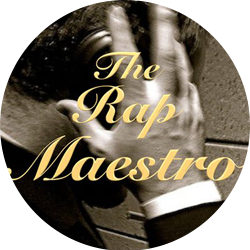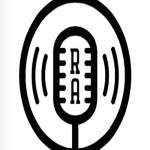The Composers Corner: Why did you start out notating rapper’s words the way you did, with
the flow diagram? Did rappers do this on their own? Did you find it
out from the work of others? Did you come up with it on your own?
Paul Edwards: It was based on what the rappers did – the idea was to mimic their
systems as closely as possible. Part of that was so that it’s “true”
to how it’s done by the actual artists, but also because their systems
usually focus on the most important things in rapping, the things you
really need to be able to show clearly.
So for example, most wrote out their lyrics with one line equal to one
bar – that kind of layout makes it easier to plan out where your
rhymes are falling within each bar, whether they’re on the 1 beat or
the 3 beat or the off-beat of the 4 beat, etc. And rhyme placement
makes a massive difference in how the rap will sound, so it’s
important to be able to “see” it on paper. Another example is showing
where a rest falls on one of the beats in bar – in a lot of battle
rapping styles, it’s crucial to include a rest on a beat after a
punchline as it gives the line so much more emphasis.
So that went hand-in-hand – notating it how the rappers notated raps
themselves and focusing on the things that were important in rapping
(as opposed to focusing on things that are important in poetry or
other music genres, for example). If it was a system that didn’t show
those things or focused on things that weren’t important in rapping,
then it would make things a lot more difficult for the reader.
I think it was also a key thing to avoid showing things that were not
needed as well, things that might “get in the way” of seeing the flow
clearly. You needed to be able to “read” the flow in real time and rap
along with it, just as the rappers did. So it had to be detailed
enough to replicate the flow accurately, but not so specific that it
was impossible to follow while you’re recording.
Also I have to give a shout out to academic author Adam Krims (RIP)
who was a pioneer in this area – he had a system with crosses and beat
numbers along the top of a chart. I’m not sure if he got that idea
direct from rappers as well, but it’s a logical way to do it and
shares some similarities with the way I do it.
The Composer’s Corner: Many people do great things, whether in sports, music, politics,
whatever, but they can’t explain why they’re good at it, or what
they’re trying to do, maybe. Your book, whether inadvertently or not,
really acts as a compendium of how rappers think of themselves as
rappers as well. What rapper struck you as being particularly
self-aware and conscious as an artist, who truly understood everything
that they were doing? That is, which rapper could explain not only
that what they were doing was great, but also why it was great?
Paul Edwards: Well, it’s tempting to answer that question by pointing to the rappers
who were able to explain the complexity of the “obvious” stuff in a
clear way. So for example, I think the people who are known as being
really “lyrical” had a lot more awareness of things like wordplay and
metaphors, and also putting rhyme schemes together and creating
rhythms, and they could talk at length about those kinds of things. So
Pharoahe Monch, Kool G Rap, Big Daddy Kane, Crooked I, Tech N9ne,
Royce Da 5’9” – those kinds of rappers where you can tell they sit
down and get really deep with the content and get really technical
with the flow. They knew a lot more about literary devices and rhymes
and rhythms – you don’t even have to ask in some cases, someone like G
Rap will bring up multisyllabic rhymes himself and start making some
up as examples.
But then I think that’s the easy way to answer that question, because
things like clever content and complex rhyme schemes are what a lot of
hip-hop fans think of as being “lyrical” and “good,” but I think
that’s partly just because they’re easier to talk about and identify,
so it’s easier to judge a rapper on those things. Content is the
easiest thing to talk about, so it gets the most attention, and then
after that are rhyme schemes, as they’re relatively easy to talk about
once you move past talking about content. The things that are much
harder to describe are things like vocal delivery and expressing
personality and overall “feel” through the delivery.
So with rappers who are really good with vocal delivery and expressing
their personality through their voice, I think they’re just as aware
of what they’re doing as the guys I previously mentioned, but it’s
harder to talk about vocal delivery in technical detail, so the
conversation and explanations around it isn’t as “precise.”
People like Shock G, B-Real, Del the Funky Homosapien, Devin the Dude,
and the guys from The Pharcyde all had a lot to say about vocal
delivery and knew how important that was to their style, but there
isn’t that much widely used or known terminology to really get into
everything they’re doing with their voices. They all knew that
bringing their fun personalities to the table and loosening up and
expressing all that character through their voices was what made them
great, but it comes out more as “I have a lot of fun when I’m
recording,” rather than more precise like “I try to make every word in
the bar rhyme and use the same compound rhyme scheme for the whole
verse.”
Then for some it’s really more of a feeling, like “it feels good to
approach the track like this,” so those types of rappers tended to be
vaguer and they talked about bringing a certain “feel” to the track –
not really thinking about it too much, just letting it happen. And
that’s exactly what fans of those types of rappers like about them
usually, they’re not ultra-rhymey or doing crazy fast rhythms or
anything like that, they sink casually into the music and play around
on the beat in a free kind of way. In those cases, some rappers
actually said to me, “don’t make me think about it too much, because
then I might not be able to do it again in the future!” It’s like the
analysis can be detrimental for some artists, especially if they have
a simpler style and it’s more of a feel thing.
So I think pretty much all the rappers were aware of what made them
great and could express it, it’s just that some of the things that
make someone great are harder to put into precise language than other
things.
The Composer’s Corner: What have you been up to since How To Rap 2? Will there by a third?
Why or why not?
Paul Edwards: Right after “How To Rap 2” I got a deal to do “The Concise Guide to
Hip-Hop Music” with St. Martin’s Press. That book just came out, it
was released in February this year, and so writing that and preparing
for its release was what I did between “How To Rap 2” and now.
That’s a book I thought was really important to do, as often people
know some hip-hop knowledge here and there, but they don’t have an
overall framework of how things developed and how they fit together –
they don’t have a fundamental template to work from basically. I
wanted to give people that in a clear, brief way, like what things
hip-hop fans listen for and how listening to hip-hop is different from
listening to other music genres. I also look at how rapping and
beatmaking developed and things like “hip-hop instruments” (different
types of samplers, etc.) as well as debunking some popular myths along
the way. It’s written a bit differently from How To Rap, because with
the How To Rap books those are 100% my own interviews, while with this
new one I used a mix of my own interviews and quoting existing
sources.
I’m not sure at the moment if there will be a How To Rap 3, though
it’s possible. There’s plenty of stuff left to cover and more info
from the same set of interviews that hasn’t been used yet, but I also
have some other book ideas that I would like to do first, before
thinking about a potential How To Rap 3.
If I do another one, it’ll probably go in depth in areas that really
aren’t covered that much, things I think are really interesting and
are things that would push hip-hop forward. Areas where there is still
a lot of room for innovation that haven’t been fully explored yet.
The Composer’s Corner: It’s occurred to me that listeners know how they themselves
understand and relate to rap music, and they obviously know that
rappers understand and relate to rap music in some way, but most
listeners, not being very close to the rappers themselves, haven’t
ever really thought of just how and in what ways rappers relate to
their art form. That’s why the ability of Jay-Z or Lil Wayne or
Notorious BIG to write rhymes without paper, or for Kendrick to rap
“Rigamortus” on just the 3rd take, is so popular and incomprehensible.
In all of your interviews, what have you learned about how rappers
think of rap?
Paul Edwards: I think it’s different from rapper to rapper – there are definitely
some who like to keep a kind of secrecy around it or try to
mythologize it, because it makes them seem more impressive. If it’s
seen as some kind of magic power or where you write songs in 30
seconds and things like that, it makes it all seem more mysterious to
people who don’t know how it’s done.
But the rappers who really open up about how they do it, they talk
about it in a very matter-of-fact way, as one rapper described it to
me: “a bunch of grown men and women just sitting around writing some
raps.” They usually see themselves simply as writers and vocalists.
The unusual thing with rapping is that most rappers have learned
independently from each other, not really knowing how other rappers do
it. In contrast, something like playing the guitar doesn’t have that
kind of disconnect from other guitarists – you know when you begin
playing how most other people have done it, either through learning
chords from a book or getting lessons with a guitar teacher most of
the time. No one really tries to figure out the guitar and all the
chord combinations from scratch, or just from listening to records
with guitarists on them.
So what was funny was often at the end of the interviews, the rappers
would ask me what other rappers did, especially when they heard who I
had interviewed already. They were interested to know how other
rappers were doing it and if they were doing something different or
similar to the “rest of the crowd” or if there were any weird methods
they hadn’t heard of before.
The Composer’s Corner: As someone who has interviewed tons of rappers, what advice would
you give to a music journalist who wants to get better at interviewing
them?
Paul Edwards: I think it really depends what you’re interviewing them for – doing it
for a book is probably a lot different than doing it for a magazine or
website, especially if it’s a book where you’re using bits and pieces
rather than printing the entire interview in the order it happened.
With my books, I had very specific information I wanted to find out,
so I put together questions that would hopefully draw out the kind of
info I needed.
As I was doing the interviews and hearing the answers I was thinking
things like, “ok, that sentence he just said will fit over there to
help explain that technique, but maybe try to get a bit more info on
this other specific thing, as I know I need more quotes for this
section”… it’s like you’re partially piecing together the book as
you’re interviewing. And with a book, you’re normally doing it all on
one subject, so you don’t really want to go off on any big tangents,
as interesting as they might seem at the time.
While for a website or magazine or a radio interview, it can really go
anywhere and it usually needs to be interesting just as a conversation
all the way through, because people are going to read or listen to the
whole thing in the order it happened. So for me personally, it helped
to ask specific questions that drew out answers that would fit in
certain sections of the books and I had to really stay on topic as
much as possible. But that kind of advice probably won’t help someone
doing a “regular” interview, because it’s so different.
Though the one big piece of advice that probably applies across the
board is to make sure your recording set up is good if it’s a phone
interview or in person, as you don’t want to lose all the answers! I
had two tape recorders set up to my phone back when I did my
interviews, where one of them was a backup.
The Composer’s Corner: Was there one rapper you really wanted to ask these questions but
never got a chance to? Who would it be?
Paul Edwards: Oh man, there were lots, particularly MCs who are no longer alive.
Those are the ones where in hindsight there was only a narrow window
for journalists and historians to interview them and preserve their
methodologies, so it’s a shame from a historical perspective that that
info hasn’t been documented in some cases. For example, interviewing
Big Pun would have been great, he was really the next MC to really go
all out with that compound rhyme style after Kool G Rap did it, and of
course Big L as well, it would have been great to ask him about
writing “Ebonics” as that’s such a clever concept. Guru from Gang
Starr and Pimp C from UGK are rappers I actually tried to get hold of
at the time, but unfortunately those interviews never happened.
The Composer’s Corner: What do you think of Kendrick Lamar as an MC?
Paul Edwards: I think he’s a great MC, especially from a technical point of view –
his flow, content, it’s all there, so it’s great there is someone at
the forefront who has that ability and is taking some risks,
musically. He’s not actually someone I listen to for my own enjoyment,
just because I don’t really like his voice (or the different ones he
uses on different tracks), but that’s a very subjective thing, whether
you like someone’s voice or not.
Also the beats really have to be in a style I like for me to enjoy the
music, even if the rapper is incredible. I’m a big fan of raw, sampled
beats with a lot of texture and grit, so like Sir Jinx in the early
90s, DJ Muggs on the first couple of Cypress Hill albums, Dr Dre on
the second NWA album, Large Pro, DJ Premier, DITC, those types of
beats, and guys who pushed sampling forward like DJ Shadow and Cut
Chemist, where they were chopping up samples and putting them in
different time signatures and things like that.
So probably with the right production he would be someone I’d listen
to a lot more, just because my taste in beats is quite different from
the ones he tends to use.
———–
If you liked this article, you might enjoy these other ones, which are among my most popular:
1.) An analysis of Nas’ flow on the 2006 Busta Rhymes song “Don’t Get Carried Away,” which you can read here.
2.) My album review & analysis of the 2012 Kendrick Lamar album “good kid, m.A.A.d city,” which you can read here.
3.) A database of who the 23 most repetitive rappers in the industry are, available here.
4.) A study of every instrument Dr. Dre used on his songs between the years 2000 and 2009, online here.
5.) A breakdown of Eminem’s song “Business,” which you can check out here.


 Join the weekly RapAnalysis newsletter at
Join the weekly RapAnalysis newsletter at